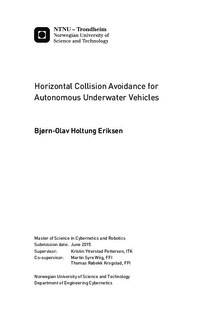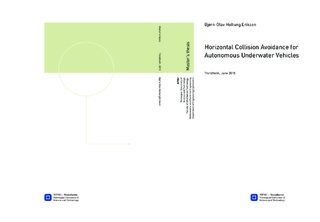| dc.description.abstract | Vast amounts of research has been done on the subject of collision avoidance. However, limited effort has been put into adapting collision avoidance algorithms to vehicles with second order non-holonomic constraints, such as Autonomous Underwater Vehicles (AUVs). This thesis assesses the Dynamic window algorithm applied to a HUGIN 1000 AUV for reactive horizontal collision avoidance, with constant irrotational ocean current. A simulator for the AUV with sonar sensors and an integral line of sight (ILOS) guidance system has been developed, and is used to implement and test the algorithm.
The original Dynamic window algorithm is not intended for use on vehicles with second order non-holonomic constraints. A thorough literature study on modifications and extensions to the algorithm is presented. A number of modifications have been made to the original algorithm to make it better suited for use with the HUGIN 1000 AUV. In particular, a new method for predicting AUV trajectories which accounts for second order non-holonomic constraints and ocean current has been developed.
Using Lyapunov theory, convergence to a straight line path is proved with UGAS and ULES stability properties under the assumption that no obstacles are present. The proof include ocean current, and is a first step of a complete stability proof for the collision avoidance system. Simulations support the proof. The performance of the modified Dynamic window algorithm has been assessed through simulations. When not faced with local minima, collisions are avoided both with and without ocean current. The simulations infer that the algorithm also avoids collision when faced with local minima, but due to inaccuracies in the simulation model no definitive conclusion can be made.
The new trajectory prediction method reduces the mean square prediction error to about one percent compared to the original method, and makes the Dynamic window algorithm well suited for vehicles with second order non-holonomic constraints such as the HUGIN 1000 AUV. | |

